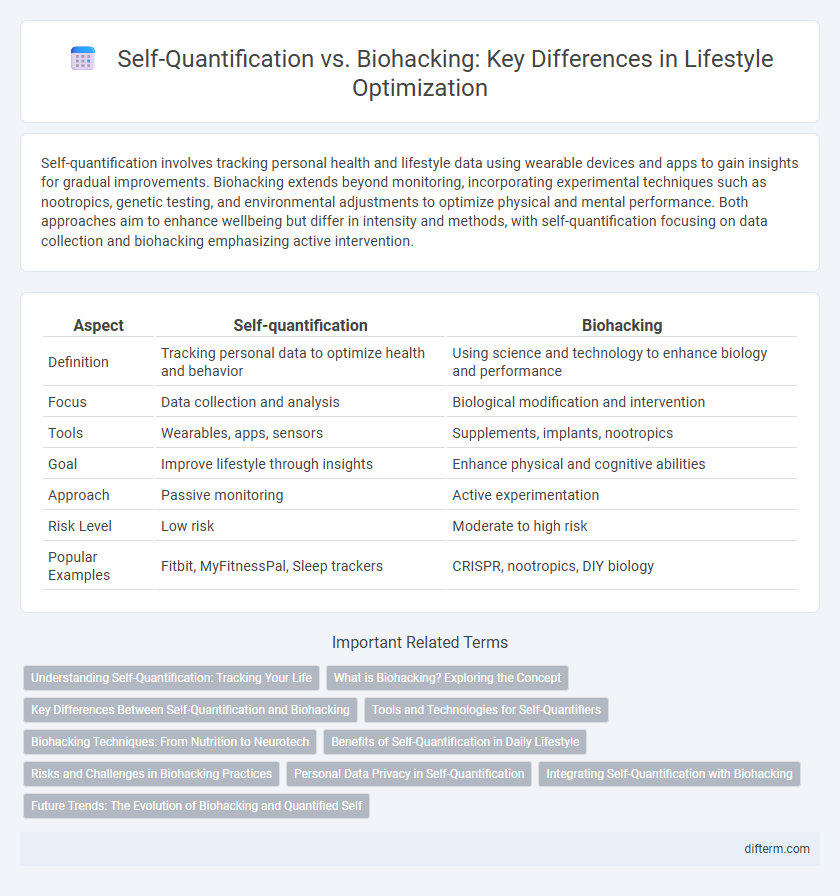Self-quantification involves tracking personal health and lifestyle data using wearable devices and apps to gain insights for gradual improvements. Biohacking extends beyond monitoring, incorporating experimental techniques such as nootropics, genetic testing, and environmental adjustments to optimize physical and mental performance. Both approaches aim to enhance wellbeing but differ in intensity and methods, with self-quantification focusing on data collection and biohacking emphasizing active intervention.
Table of Comparison
| Aspect | Self-quantification | Biohacking |
|---|---|---|
| Definition | Tracking personal data to optimize health and behavior | Using science and technology to enhance biology and performance |
| Focus | Data collection and analysis | Biological modification and intervention |
| Tools | Wearables, apps, sensors | Supplements, implants, nootropics |
| Goal | Improve lifestyle through insights | Enhance physical and cognitive abilities |
| Approach | Passive monitoring | Active experimentation |
| Risk Level | Low risk | Moderate to high risk |
| Popular Examples | Fitbit, MyFitnessPal, Sleep trackers | CRISPR, nootropics, DIY biology |
Understanding Self-Quantification: Tracking Your Life
Self-quantification involves systematically tracking personal data such as sleep patterns, physical activity, and dietary habits using wearable devices and mobile apps to gain insights into health and lifestyle trends. This data-driven approach helps individuals identify patterns and make informed decisions to optimize well-being. Unlike biohacking, which often includes experimental interventions to enhance biology, self-quantification emphasizes consistent monitoring and analysis for gradual, evidence-based lifestyle improvements.
What is Biohacking? Exploring the Concept
Biohacking refers to the practice of using science, technology, and lifestyle changes to optimize physical and mental performance. It involves techniques like genetic modification, nootropics, and wearable devices to monitor and enhance biological functions. This hands-on approach aims to improve health, cognition, and overall well-being beyond traditional self-quantification methods.
Key Differences Between Self-Quantification and Biohacking
Self-quantification involves systematically tracking personal data such as sleep, diet, and exercise using wearable devices and apps to improve lifestyle choices. Biohacking extends beyond data monitoring, incorporating experimental techniques like nootropics, genetic testing, and microbiome manipulation to enhance physical and cognitive performance. While self-quantification emphasizes data collection and analysis, biohacking prioritizes active intervention and modification of biological processes for optimization.
Tools and Technologies for Self-Quantifiers
Self-quantifiers utilize advanced wearable devices, smartphone apps, and biometric sensors to track physiological metrics such as heart rate variability, sleep patterns, and glucose levels with high precision. These tools integrate AI-driven analytics and cloud platforms to provide personalized health insights and predictive data modeling. Continuous innovations in non-invasive monitoring technologies and data visualization software enhance user engagement and enable real-time health optimization.
Biohacking Techniques: From Nutrition to Neurotech
Biohacking techniques encompass a wide range of practices from nutrition optimization, such as personalized supplementation and ketogenic diets, to advanced neurotech methods like transcranial direct current stimulation (tDCS) and nootropics for cognitive enhancement. These interventions aim to improve physical and mental performance by leveraging data-driven insights and cutting-edge technology. By integrating wearable sensors and brain-computer interfaces, biohackers can track physiological responses in real-time and fine-tune their lifestyle for maximal health and productivity.
Benefits of Self-Quantification in Daily Lifestyle
Self-quantification enhances daily lifestyle by providing precise data on physical activity, sleep patterns, and dietary habits, enabling informed decisions for improved health. Tracking metrics such as heart rate variability and calorie intake fosters greater self-awareness and personalized wellness strategies. This data-driven approach supports habit formation, boosts motivation, and leads to sustainable lifestyle changes without invasive interventions.
Risks and Challenges in Biohacking Practices
Biohacking practices carry significant risks including unregulated use of supplements, potential side effects from experimental interventions, and gaps in scientific validation. Self-quantification offers safer, data-driven insights through wearable technology and biometric tracking but may lack the transformative impact sought by biohackers. Navigating ethical concerns and long-term health consequences remains a critical challenge within the biohacking community.
Personal Data Privacy in Self-Quantification
Personal data privacy in self-quantification raises critical concerns as users collect extensive biometric and behavioral information through wearable devices and apps. Unlike biohacking, which often involves experimental biological modifications, self-quantification emphasizes data-driven insights but risks exposure to data breaches and unauthorized data sharing. Safeguarding personal health metrics requires robust encryption, transparent privacy policies, and user control over data access to prevent misuse in self-tracking ecosystems.
Integrating Self-Quantification with Biohacking
Integrating self-quantification with biohacking enhances personalized health optimization by leveraging continuous biometric data monitoring and experimental lifestyle adjustments. Wearable devices and apps track metrics like sleep patterns, heart rate variability, and glucose levels, providing actionable insights for biohackers to fine-tune nutrition, exercise, and recovery protocols. This synergy between data-driven analysis and targeted interventions accelerates achieving peak physical and cognitive performance.
Future Trends: The Evolution of Biohacking and Quantified Self
Emerging trends in biohacking and self-quantification emphasize personalized health optimization through advanced wearable technologies and AI-driven data analysis. Integration of genomics, real-time biometrics, and machine learning is revolutionizing preventive medicine and lifestyle customization. These innovations promise enhanced human performance, longevity, and precision wellness strategies tailored to individual biological data.
Self-quantification vs Biohacking Infographic

 difterm.com
difterm.com